Field Test: White’s TDI SL 12 Metal Detector Review
Published by Jenna Anderson on 08/05/19
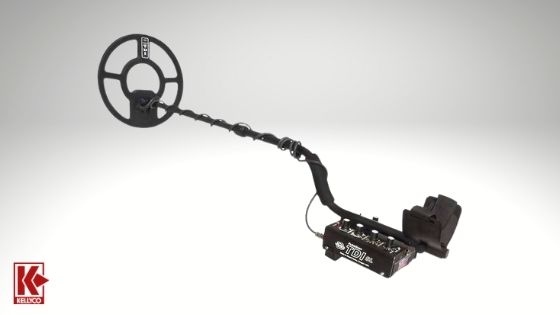
TDI SL 12 Metal Detector
When the uranium boom ended in the late 1950’s, Ken switched his focus to metal detecting equipment and, as they say, he and his company never looked back. Over the ensuing decades, White’s became an industry leader by continuing to produce quality, innovative equipment which has uncovered countless valuable coins, artifacts, relics, minerals and jewelry worldwide. The latest addition to the White’s line is the result of more than two years of extensive research and development at sites spanning the globe, and was intended to provide users with the latest technology and an edge over the competition. Having used a number of White’s detectors over the years, starting with a Coinmaster IV back in the late 1960’s, I was looking forward to giving the new PulseScan TDI metal detector a try at some sites throughout the southeast.
When the uranium boom ended in the late 1950’s, Ken switched his focus to metal detecting equipment and, as they say, he and his company never looked back. Over the ensuing decades, White’s became an industry leader by continuing to produce quality, innovative equipment which has uncovered countless valuable coins, artifacts, relics, minerals and jewelry worldwide. The latest addition to the White’s line is the result of more than two years of extensive research and development at sites spanning the globe, and was intended to provide users with the latest technology and an edge over the competition. Having used a number of White’s detectors over the years, starting with a Coinmaster IV back in the late 1960’s, I was looking forward to giving the new PulseScan TDI metal detector a try at some sites throughout the southeast.
Features
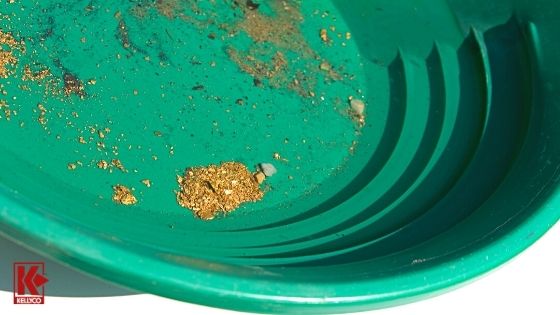
Gold Prospecting
While the PulseScan TDI metal detector is based on the Pulse-Induction or PI-circuit, it is unlike any other PI-detector currently available. Forging an alliance with Eric Foster, a recognized PI expert, White’s set out to develop a detector that was able to offer industry-setting performance under even the most severe ground conditions while adding some unique features. While PI detectors have been around for decades, their use has generally been limited to specialty applications, such as salt water beach hunting or some gold prospecting, due to some inherent limitations such as an affinity to iron and, in many cases, their overall weight.
One feature that PI-detectors are well known for is the ease at which they can be setup; i.e., typically one or two simple adjustments are all that are needed to achieve optimal performance. The White’s development team wanted to retain that ability in the new PulseScan while adding some new features not found on any other PI-type detector.
One of the first things one notices when unpacking the TDI metal detector is that there is no meter or LCD screen as many have come to expect from a high-end detector. As one quickly realizes, the TDI metal detector is capable of providing superior detection depth with a unique form of audio target ID that therefore negates the need for a visual meter.
Looking strictly at the numbers, the TDI metal detector is heavier than most detectors at a tad over 5 lbs. with the 12″ Dual Scan coil and 14.4V Lithium Ion battery pack; however, as typical with most White’s units, it’s well balanced, making it feel significantly lighter and one can hunt with it for extended periods without fatigue. The control housing can also be attached to a belt with the built-in clip if weight does become an issue.
The TDI metal detector is controlled by three toggle switches and five knobs mounted on the top of the control housing. The toggle switches are (1) POWER ON/OFF, (2) G.E.B ON/OFF, and (3) TARGET CONDUCTIVITY LOW / ALL / HIGH.
- The POWER Toggle : is self-explanatory.
- The GEB Toggle :
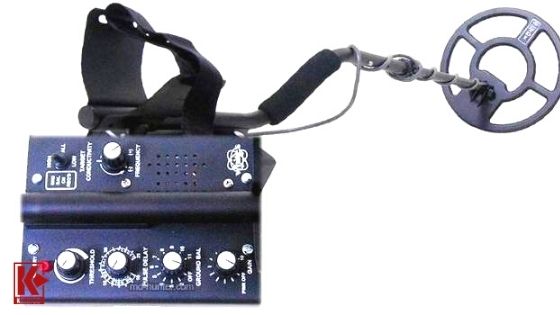
Control Box
allows users to turn the manual ground balance function off and allows the inherent ability of a PI detector to ignore most mineralized soil automatically, or turn it on and, using the GROUND BALANCE knob, precisely adjust the level of compensation needed to ignore the ground and obtain smoother performance, activate the audio target ID function and be able to search areas that even other PI detectors will not function properly in.
- The TARGET CONDUCTIVITY switch – active only when the GEB toggle is on : is one of the innovative features found on the TDI metal detector. In the ALL position, detected targets will produce an audio response based on their conductivity. High conductive targets such as silver, copper, large gold nuggets and some larger pieces of iron will produce a low-pitch tone. On the other hand, targets which have a low conductive value, such as gold jewelry, smaller nuggets, nickels, tin foil, aluminum and lead, will produce a high-pitch tone. While this may seem a bit counter-intuitive at first, after a short amount of time in the field it will become second nature and you will be able to determine with a high degree of confidence what type of target you have come across. If the toggle is placed in the HIGH position, the TDI metal detector will not produce a signal when the coil passes over a low-conductive target – in essence providing the PI-user with a unique form of discrimination. Conversely, if the toggle is placed in the LOW position, only low conductive targets will produce a response. The manual provides additional guidance on the use of this feature, but the true teacher from what I found is simply time in the field learning what type of signal different targets produce.
The knobs are (1) THRESHOLD, (2) FREQUENCY, (3) GAIN, (4) GROUND BALANCE and (5) PULSE DELAY.
- The THRESHOLD Control : is self-explanatory; i.e., it sets the background hum heard through the speaker or headphones when no target is being detected.
- The FREQUENCY Control : function is similar to a frequency shifter found on VLF detectors and allows the users to make a slight adjustment to the pulse rate of the TDI metal detector to reduce or eliminate the effect of outside interference, such as from electrical wires, radio or TV signals or even other nearby metal detectors.
- The GAIN Control : is what most detectorists call the Sensitivity control and is used to set the power output of the TDI metal detector. While running at a higher gain level will usually provide more detection depth and sensitivity, if ground mineralization or electrical interference is severe enough, running at a lower level will actually produce more stable operation and allow the user to detect targets easier than if a higher setting was selected.
- The GROUND BALANCE Control : is active when the GEB toggle is in the ON position and allows users to “tweak” the TDI metal detector to compensate for even the most severe ground conditions which might otherwise render a standard PI-detector ineffective at best. Selecting the proper setting is quite simple and far easier than most manual ground-balance VLF detectors (simply raise and lower the coil 6″ or so from the ground and adjust the knob until there is little or no change in the threshold audio).
- The PULSE DELAY Control : is unique to PI-detectors. On most pulse units, the pulse delay is a fixed value. The pulse delay is simply defined as the time between when a pulse is transmitted out from the coil and when the detector switches to receive the returning signal for analysis. Pulse delay time is measured in microseconds (uS) since the TDI metal detector sends out ~3,000 pulses per second. The control can be set from 10uS to 25uS and the specific value selected is based on the type of target you are searching for. The lower the value, the more sensitive the detector becomes to low-conductive or very small targets and this would be the preferred setting when looking for small gold nuggets or gold jewelry on a beach.
On the other hand, the higher the value, the more sensitive the TDI metal detector is to higher conductive targets such as copper or silver and the better it detects larger targets. After a number of hours in the field, I realized that this control has great potential, but it will require taking the time to learn how adjusting it affects the TDI metal detector response to specific targets. Talking to several members of the development team, they provided me with tips that allowed me to identify targets with a much greater degree of precision than I would ever thought possible with a PI-type detector. It became clear that as more experience is gathered by users worldwide, the capabilities of the TDI metal detector will expand far beyond what the designers had originally intended it to be able to do.
The PulseScan comes with two LiON battery packs to ensure you will not find yourself in a productive site with a dead battery. Three lights on the top of the control housing provide a full-time indication of remaining battery life.
Field Test
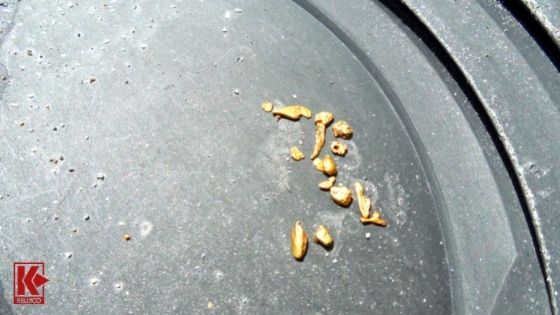
Gold Nuggets
The PulseScan TDI metal detector was developed as a professional-level detector that raises the performance bar for PI-type detectors. It was not intended to replace detectors such as the DFX, XLT or MXT for general treasure hunting, such as hunting for coins at the local trash-filled park, searching well-manicured private yards, or looking for recently lost items on the local freshwater beach. It was designed to excel at finding gold nuggets at extreme depths in highly mineralized soil typically found in gold producing areas, locate relics in severe ground while providing some degree of discrimination, or detect coins and artifacts dating back thousands of years in sites around the world that have challenged other types of detectors due to the ground conditions and depth at which the targets are located.
Based on the intended application of the TDI metal detector and discussions held with Lost Treasure Magazine and White’s Electronics, I had to adjust the sites I typically try to hunt in order to ensure my testing allowed the TDI metal detector capabilities to come through.
Since the detector was so different from what I typically use, I spent a bit more time doing some air tests and sampling targets in my test garden before heading out in the field. By combining the information contained in the draft users’ manual, input obtained from several of the Internet forums, and suggestions from fellow detectorists that had already put some time on the TDI metal detector, I greatly reduced my learning curve and was able to see how a few quick adjustments could significantly alter the TDI metal detector performance for certain types of targets; i.e., gold nuggets, relics, jewelry, etc.
South Carolina holds countless battle and skirmish sites spanning more than 300 years and, while relic hunters have been active for decades, even sites that have been heavily hunted still hold artifacts from the Revolutionary and Civil War periods. The first site I visited was one that dated back to the mid-1700’s near Charleston. While not highly mineralized, the soil was sandy which allowed targets to sink to extreme depths and, when combined with the tall grass in the area, would put the TDI metal detector detection depth capabilities to the test.
Opting to give the audio ID circuit a try, I followed the guidance in the manual for setting the Ground Balance knob when the ground mineralization was not severe enough to require a manual ground balance. Selecting a Pulse Delay of 17uS based on the targets I was looking for, I set the threshold for a comfortable level and started off. The stability and smoothness of the threshold were immediately apparent and made it easy to identify subtle changes indicating small or deep targets. Less than 20 minutes after getting started, I hit a solid signal that produced a low-pitched tone and, after digging down nearly 12”, I pulled out a nice Colonial-era flat button. While lacking any markings, I was impressed at the response the TDI metal detector had produced on a target that was that deep and covered with layers of tall, salt marsh grass.
Over the next few hours, I tried changing some of the TDI metal detector settings including Pulse Delay & Gain as well as switching between the on and off positions on the GEB toggle. Due to the moderate mineralization, I was able to run the Gain nearly to the max without any erratic operation. It might be that there were no targets deeper than about 18 inches (the deepest I hit one, which was a copper disk the size of a silver dollar), but increasing the gain from “3” to “12” did not produce any more targets or result in markedly stronger signals (not that I would have wanted to dig much deeper).

Ocean Beach
Switching into the non-GEB mode did provide a tad more detection depth on some of the lower-conductive targets and I was able to pull three musket balls out from 10″+ with solid, repeatable signals. The only negative in this mode is that the Audio ID is disabled, but if more depth is needed on certain targets, it is a trade-off worth considering. As I wrapped up my time at this site in order to head over to a nearby ocean beach, I was quite impressed with the TDI metal detector capabilities and could see, with more practice, it could easily become my prime relic detector in certain sites. Leaving the site, I drove over to Folley Beach in time to catch low tide. Anyone familiar with this section of the coast knows how bad the black sand is and Folley Beach is no exception. Opting to start in the wet sand, I determined that ground balance was required and, after a quick adjustment, headed off along the surf line with the TARGET CONDUCTIVITY switch in ALL. Once again, the threshold remained “rock-solid” and signals were easily discernable – even at the fringe of detection depth. Hoping to find a piece of jewelry, I focused on the high-pitched signals which indicated a low-conductive target. The first few targets produced low-tones and were all clad coins at depths ranging from 6″ to 8″. The first high-tone got my excitement level up, but it turned out to be a large fishhook at the same depth. Unfortunately, the next 10+ high-pitched signals all produced small iron objects such as bobby pins, fishhooks and a paperclip. Realizing that I needed to see if the TDI metal detector could provide me with some additional information to aid in identifying targets, I started to change the Pulse Delay when I received a high-tone signal. What became apparent was that on the small iron objects, the signal intensity dropped notably as the Pulse Delay was increased towards the 25uS point. On the other hand, eight nickels and a small gold charm did not exhibit this response and allowed me to identify and hence avoid digging most small ferrous items that typically plague PI-detectors.
I had the chance to do some Civil War relic hunting at a site near Marietta, Georgia, which is well known for the highly mineralized soil along the face of the mountain which contained period trenches. The heat and humidity kept me from spending a lot of time there, but, in the time I had, I was able to recover five Minnie balls and a New York State Militia cuff button from between 5” and 8” deep. Ground balancing was required, but once the simple adjustment was made, the threshold was rock-solid and signals were easily identifiable.

Old Iron Mine
Returning home, I hunted one site near an old iron mine which challenged most detectors due to the iron ore in the ground. While the TDI metal detector saw through the mineralization, the number of larger iron objects that were detected (and sounded like a high-conductive target) caused me to put the Conductivity switch to LOW and focus on the few targets that fell in that range, which included several shotgun shells, a small 18th century button (1/4” in size) and, surprisingly, three pull-tabs. While I was not able to do any gold prospecting with the TDI metal detector, I’ve watched the forums with great interest and have seen some impressive finds being made by prospectors in the western states and Alaska – most notably Steve Hersbach from Anchorage.
The flexibility of the TDI metal detector and the impact even slight changes to individual controls had on overall performance was clearly demonstrated during the testing I was able to do, and it was easy to see that the full capability of the new TDI metal detector will be uncovered as more users get to try the detector in various applications and in different ground conditions
Summary
The PulseScan TDI metal detector was developed to provide serious detectorists a piece of equipment that was not simply a “re-hash” of existing technology in a new housing. Initially developed to meet the demands of gold prospectors searching for both extremely small and extremely deep nuggets, the TDI metal detector has evolved into a detector that has proven itself as an effective detector for relic hunting, beach hunting and, under the right conditions, even coin hunting.
The PulseScan TDI metal detector is not for everyone…if you are looking for a detector that offers professional-quality performance under even the most severe ground conditions for specific applications and are willing to invest the time needed to master it, the PulseScan TDI metal detector will give you an edge over the competition. While I have nowhere near the amount of field time those that have been working on developing the TDI metal detector over the past two years do, I find myself learning a new technique or trick each time I go out and, with each lesson learned, my results improve at the end of the day.
While at first glance the TDI metal detector seems to be fairly simple to operate, the subtle nuances that will make you successful under different conditions is the reason White’s has taken the position that a dealer needs to have been trained on how to operate the TDI metal detector in order to be able to then train the customer on its operation. As well-known detectorist and prospector Steve Hersbach says, “The bottom line – the worse the ground mineral conditions get, the better this machine will fare compared to a VLF unit.”
Whites TDI SL
White’s TDI SL metal detector meets the demands of gold prospectors looking for both extremely small and extremely deep nuggets. It’s simple to operate. Includes 12″ dual field search coil, one Lithium Ion rechargeable battery pack and a two-year warranty. A 7.5 ” dual scan coil is also available.
Weight: 3.5 lbs.
Frequency: PI
Waterproof: No
Warranty: Two-year
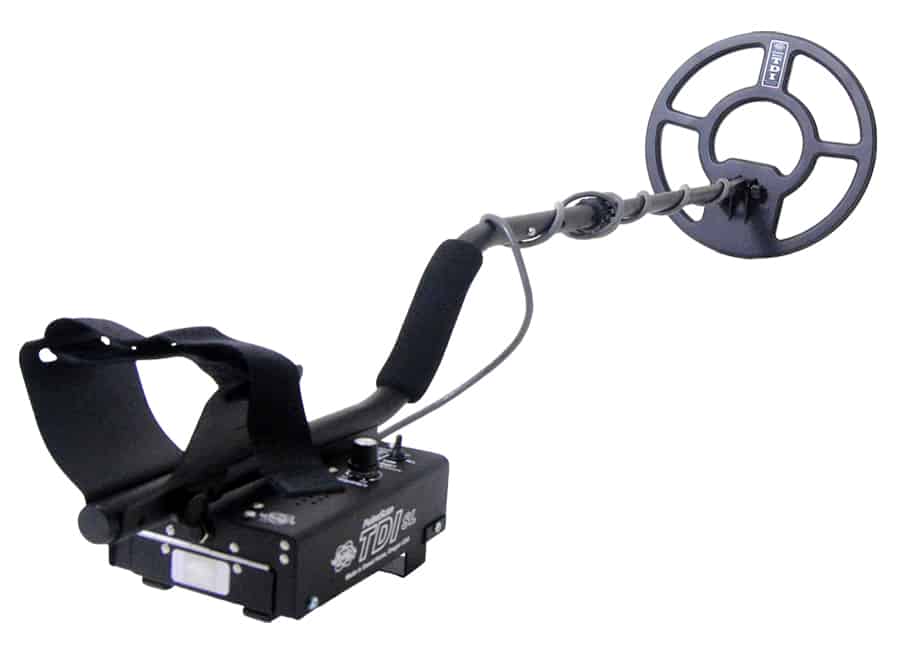
- Very stable in salt water
- Simple rejection switch for metal conductivity
- Lightweight
- Low discrimination ability
- Not waterproof
- I bought my TDI in September of 2014. I use this machine to hunt wet sand on beaches for coins and jewelry and it is awesome for deep finds and mineralized wet sand. WARNING!!! It finds everything made of metal!! It's not uncommon to fine a bobby pin at 18 inches. But... that could have been a gold ring too! I use the "HIGH" setting in parks to look for coins and it finds silver very well. Many quarters and dimes and some medium sized rings but not many pennies at that setting and very little iron or pull tabs. It is a high producer in heavily trashed ground. Where it really shines is when I prospect for gold nuggets. I've found several here in Oregon and it has no problem in tailings and mineralized ground. It's light weight and extreme sensitivity make this a real go-getter of a metal detector.
- Dennis P

